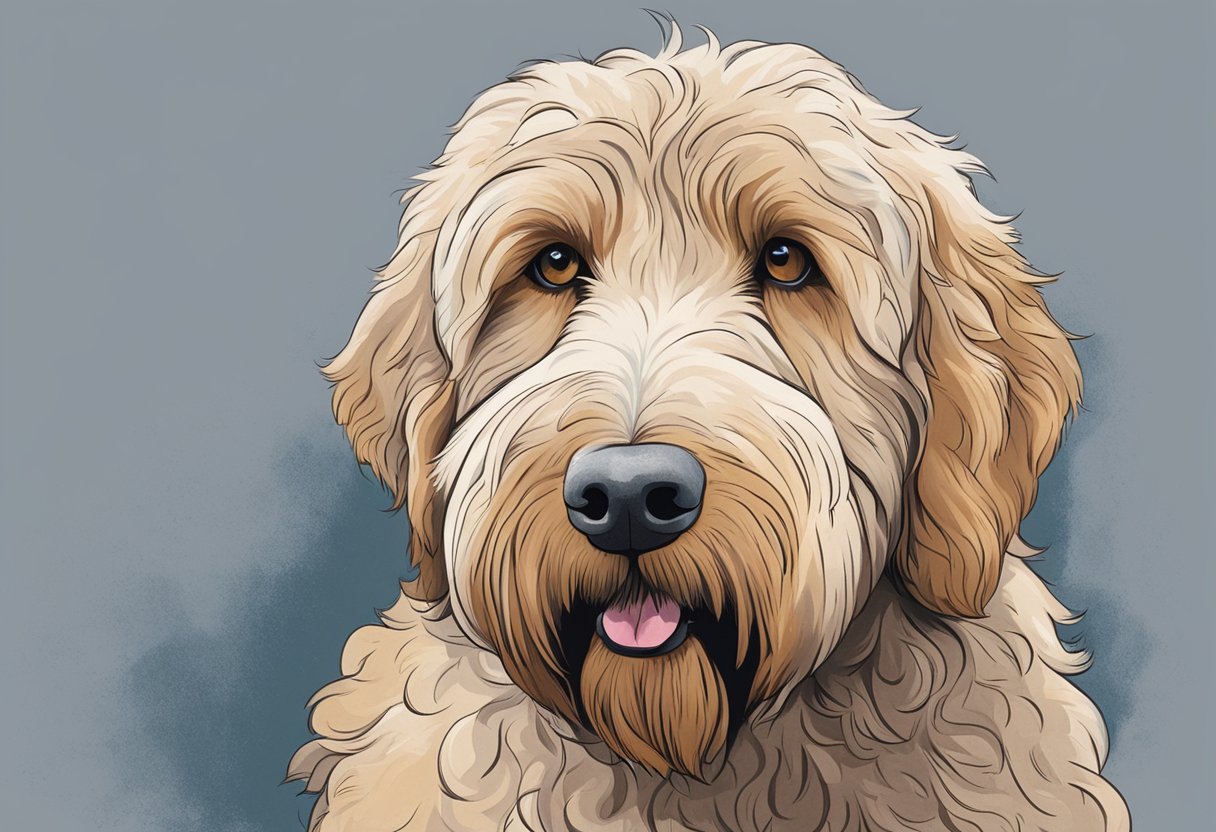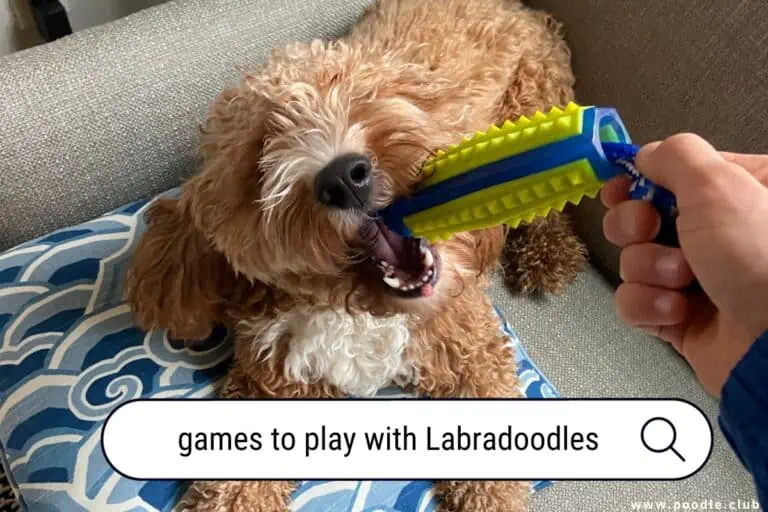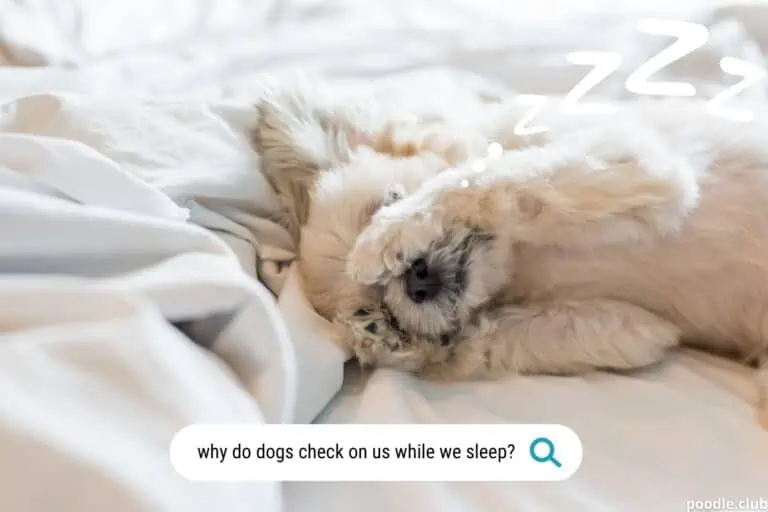Is My Labradoodle Anxious? Understanding Your Dog’s Behavior
Labradoodles are known for their lovable nature and intelligence, but like any other dog breed, they can experience anxiety. As a Labradoodle owner, it’s important to be aware of your dog’s emotional wellbeing and recognize the signs of anxiety.
This will enable you to appropriately address any issues and provide the best care for your furry friend.
Understanding your Labradoodle’s behavior is crucial as it helps to identify when they are anxious and determine the underlying causes.
Anxiety can manifest in various forms, such as separation anxiety or response to specific triggers. By correctly interpreting your Labradoodle’s actions and exploring potential causes, you can create a comforting environment and develop strategies to alleviate stress.

Key Takeaways
- Be aware of your Labradoodle’s emotional wellbeing and recognize signs of anxiety.
- Understand the causes and various forms of anxiety in your Labradoodle.
- Address anxious behavior by creating a comforting environment and implementing strategies to reduce stress.
Understanding Labradoodle Behaviour
As a Labradoodle owner, you may have noticed your dog’s unique behavior traits. Labradoodles are intelligent dogs, known for their enthusiasm and loyalty. In order to decipher if your Labradoodle is anxious, you need to understand their typical behavior and body language.

One of the key aspects of understanding Labradoodle behavior is observing their body language. Pay attention to your dog’s ears, tail, and posture. When Labradoodles are relaxed, their ears are typically at ease, not pinned back or perked up.
Their tail will be wagging gently, and their posture will be relaxed.
On the other hand, if your Labradoodle is displaying signs of anxiety, some noticeable differences in their behavior may arise. An anxious Labradoodle may have its ears pinned back, its tail tucked between its legs, and its body hunched over.
Labradoodles are intelligent dogs, which means they can quickly adapt to situations and exhibit a wide range of emotions. It’s crucial to study your Labradoodle’s typical behavior to accurately recognize when something might be wrong.
In summary, understanding your Labradoodle’s behavior and body language is essential for accurately identifying signs of anxiety. Stay attentive to your dog’s ears, tail, and posture, while considering their general demeanor and intelligence. By doing so, you will become attuned to your Labradoodle’s emotions and more capable of addressing their needs.
Signs and Symptoms of Anxiety
As a Labradoodle owner, it’s important to understand the signs and symptoms of anxiety in your dog. Anxiety can manifest in various ways, and being able to recognize them will allow you to help your pet and address any underlying issues.

One common sign of anxiety is nervous panting. If your Labradoodle is panting excessively, even in a cool environment, it could be an indication that they are feeling anxious. Keep an eye out for this behavior, as it can be a clear indicator that something’s off.
PuppySpot is a reputable dog marketplace where you can browse and find compatible puppies right from the comfort of your home. They have placed over 200,000 puppies into homes in the US!
Your Labradoodle may also become quiet and withdrawn when experiencing anxiety. Typically, they may seek out hiding spots or corners to avoid interaction. Remember, this is a sign of stress, so be supportive and patient when checking on them.
Whining, barking, and howling are some vocal expressions your dog may use when feeling anxious. These can be attention-seeking behaviors, signaling that your Labradoodle is uncomfortable and needs reassurance or help.
Your pet may exhibit destructive behavior such as chewing on furniture, walls, or other household items. This can be their way of coping with anxiety and stress. Monitor their surroundings and provide them with safe and appropriate chewing alternatives, like toys, to ease their nervousness.
Lastly, pacing is a common sign of anxiety in dogs. If your Labradoodle keeps walking back and forth in the same area or circles around continuously, it is possible they are feeling uneasy. Try creating a calm environment and encourage your pet to relax.
By staying informed and paying attention to your Labradoodle’s behavior, you can identify anxiety in its early stages and take the necessary steps to help your furry friend feel more comfortable and secure.
Separation Anxiety in Labradoodles
Separation anxiety is a common issue that can affect your Labradoodle. This condition occurs when your dog becomes extremely anxious and fearful when left alone. As a result, your furry friend may exhibit various behaviors such as destructive chewing, excessive barking, or even urinating in inappropriate places.

Symptoms of separation anxiety in Labradoodles may include:
- Destructive chewing: This is one of the most common signs of separation anxiety. Your Labradoodle may chew on furniture, clothes, or other belongings when left alone.
- Urinating and defecating indoors: If your normally house-trained Labradoodle starts to have accidents indoors when you are away, this could be a sign of separation anxiety.
- Excessive barking and whining: Your Labradoodle may vocalize excessively when left alone due to the fear of being separated from you.
- Pacing and restlessness: An anxious Labradoodle may pace or show other signs of restlessness when left alone.
- Attempts to escape: In some cases, your Labradoodle might try to escape from the room or confined area they are left in, potentially resulting in injury.
To help reduce separation anxiety in your Labradoodle, consider trying the following strategies:
- Gradual desensitization: Slowly increase the amount of time your Labradoodle is left alone, starting with short periods and gradually building up to longer durations.
- Provide mental stimulation: Leave interactive toys, puzzles, or treat-dispensing toys for your Labradoodle to engage with while you are away.
- Establish a consistent routine: Maintain consistency in your daily schedule to help your Labradoodle feel more secure and predict when separations will occur.
- Reward calm behavior: Praise and reinforce your Labradoodle for being calm and relaxed when you are home together.
In more severe cases of separation anxiety, consult with a professional, such as a veterinarian or a certified dog behaviorist, for guidance on managing and treating the issue.
Dealing with Anxious Behavior
When dealing with your Labradoodle’s anxious behavior, it’s essential to approach the situation with patience and understanding. Remain calm and remember to communicate with your dog in a confident, clear, and neutral manner.

In many cases, it’s best to consult with your veterinarian to rule out any underlying health issues that may contribute to your dog’s anxiety. They can also recommend additional tactics and resources to help your dog feel at ease.
Training plays a significant role in addressing anxiety in your Labradoodle. Using positive reinforcement methods will help build their confidence while emphasizing their focus on you. Reward your dog when they show signs of calm behavior and remain patient as your dog learns new coping skills.
Keep in mind that every dog is different, and consistency is vital in the training process.
Creating a comfortable environment for your Labradoodle is another crucial aspect of managing anxiety. Designate a specific area in your home as their safe haven, where they can retreat when feeling overwhelmed. This space should be equipped with items that provide comfort, such as their favorite toys and a cozy bed.
It is important to maintain a relaxed demeanor when interacting with your anxious Labradoodle. Dogs are highly attuned to their owner’s emotions, and they may pick up on your nervousness, which could exacerbate their anxiety. Instead, lead by example and demonstrate the calm behavior you want your dog to emulate.
Throughout the process, remember that open communication between you and your Labradoodle is crucial. Pay attention to their body language and respond accordingly. Over time, they will associate your presence with safety and well-being, making it easier for them to cope with anxiety.
By implementing these strategies, you can help your Labradoodle overcome their anxious behavior and lead a happier, more relaxed life.
Creating a Comforting Environment
In order to help your Labradoodle feel more relaxed, it is important to create a comforting environment for them. Start by providing a designated safe space, such as a crate. Crate training your dog can help them feel secure and ease anxiety.

Make sure to place comfortable bedding and their favorite toys inside the crate, so they can associate it with a positive and cozy atmosphere.
Maintaining a consistent routine is also key to reducing your Labradoodle’s anxiety. Make sure to feed them and take them on walks at the same scheduled times every day. This regularity will help them feel more secure and know what to expect.
During meal times, provide nutritious food that meets their specific dietary needs.
Socialization and companionship play a vital role in your dog’s mental well-being. Introduce them to new friends, both human and other dogs, to build their confidence and increase their exposure to various social situations. Regular trips to the park can provide an excellent opportunity for this type of interaction.
Toys are also great tools to keep your Labradoodle engaged, stimulated, and entertained. Provide a variety of toys to prevent boredom, which could contribute to anxious behaviors. Interactive toys, like puzzle feeders, can also help keep their mind active and reduce stress.
Lastly, remember that your presence and demeanor have a strong impact on your dog’s anxiety levels. Stay relaxed and calm around your Labradoodle, as they can pick up on your emotions. If you are confident and knowledgeable in their care, it will contribute to their overall sense of comfort and well-being.







![How To Stop A Dog From Howling [Guide]](https://poodle.club/wp-content/uploads/2023/08/how-to-stop-dogs-from-howling-768x512.webp)